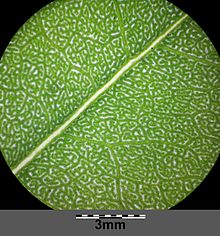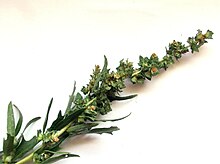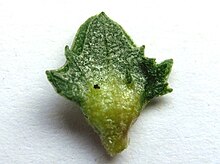Tatar report
| Tatar report | ||||||||||||
|---|---|---|---|---|---|---|---|---|---|---|---|---|

Tatar message ( Atriplex tatarica ) |
||||||||||||
| Systematics | ||||||||||||
|
||||||||||||
| Scientific name | ||||||||||||
| Atriplex tatarica | ||||||||||||
| L. |
The Tatar Melde ( Atriplex tatarica ), also known as Tatar Melde , is a species of the report ( Atriplex ) in the foxtail family (Amaranthaceae). In the German-speaking area, the species is mainly native to Austria, but is now also spreading in parts of Lower Saxony.
description
Vegetative characteristics
The Tatar Melde is an annual herbaceous plant . Their upright, prostrate stems on salty sites usually reach a height of 30 to 80 cm (up to over 150 cm). It is heavily branched with obliquely protruding or ascending whitish branches with a bare or initially lightly floured surface.
The (except the lowest) alternate arranged on the stem leaves have a length of 3 to 7 cm (up to about 10 cm) and a width of 1 to 4 cm on. The lower leaves are stalked up to 2 cm long, the upper almost sessile. Their leaf blades, densely covered with bladder hairs, which are gray-silvery on the underside and green or gray on the top, are triangular-ovoid to elongated-lanceolate, with a wedge-shaped or almost spike-shaped base. The leaf margin is irregularly serrated or lobed to three-lobed and curled, the top leaves are almost entire. The leaf shape of this species is very variable.
Inflorescence and flower
The Tatar registration is single sexed ( monoecious ). In annual inflorescences that have almost no bracts, the flowers are in dense or distant spherical clusters. The male flowers have four to five bracts ( tepals ) and five stamens with elongated anthers . The female flowers, which occur several tufted are, of two rhombic-ovoid continue reading sheathed bloom are absent; they contain only one vertical ovary .
The heyday of the Tatar registration in Germany extends from July to September. The pollination is usually done by the wind, but is also possible by insects.
Fruit and seeds
The vertical fruit is enveloped by up to half of the intergrown before leaves, which harden to cartilage at the fruiting time and are then yellowish-white and clearly veined in the lower middle. The seated or short-stalked prophylls are rhombic to ovate or almost fan-shaped with a length of 3 to 8 mm (rarely up to 10 mm) and a width of 3 to 7 mm. Its edge is serrated irregularly or partially has two side lobes. They sometimes have a few knotty appendages on their back.
The membranous whitish pericarp surrounds the seed. There are red, convex seeds with a diameter of 1.5 mm and light brown, flat to concave seeds with a diameter of 1.5 to 2.5 mm ( heterocarpy ).
Chromosome number
The number of chromosomes is predominantly 2n = 18 (in an investigation, 2n = 36 was also given).
Photosynthetic pathway
The Tatar melde is a C 4 plant with a wreath anatomy .
ecology

The Tatar melde is a food plant for the butterfly caterpillars of the mini-sac carrier Coleophora serinipennella .
Occurrence

The natural distribution area of the Tatar registration includes East-Central , East and South Europe , North Africa , West Asia and Central Asia to China . There it populates the banks of saline waters, semi-deserts and sandy, saline deserts as well as ruderal sites up to altitudes of 1800 meters (rarely up to 3000 meters). This species thrives in a wide climatic range up to the boreal zone . Their main distribution area is in the lowlands of the Iran-Turanian zone.
The Tartar registration is introduced in many other regions. It is naturalized in parts of Central and Northeastern Europe and occurs occasionally in Northern Europe . It has also been introduced to the coasts of North America . Outside of their natural area, they are found almost exclusively in human-influenced ( anthropogenic ) locations.
In Austria the species occurs scattered in the Pannonian area on dry, mostly skeletal and nutrient-rich ruderal fields and on roadsides polluted with road salt in the colline altitude. The natural occurrences are limited to the federal states of Vienna , Lower Austria and Burgenland , in Styria and Carinthia only inconsistent occurrences are known on railway systems.
In Germany, the Tataren-Melde is a naturalized neophyte . As a continental species it occurs mainly in East Germany, in the other parts of the country it occurs only rarely and inconsistently. It grows in short-lived weed corridors , for example at train stations, docks, roadsides or rubbish dumps on nutrient-rich sand and stone soils. In the system of plant sociology, its main occurrence in Central Europe is in the Sisymbrion association . In the Mediterranean region it occurs in companies of the Chenopodion muralis association. It is considered a pointer plant for full sun, dryness and warmth (steppe climate).
Systematics
The Tataren-Melde ( Atriplex tatarica ) belongs to the C 4 -Atriplex-Clade within the genus Atriplex . With the lobed melde ( Atriplex laciniata ) and other closely related species, it is combined to form the Atriplex tatarica aggregate.
The first publication of Atriplex tatarica was made in 1753 by Carl Linnaeus in Species Plantarum , 2, p 1,053th
Since the Tatar report is extremely variable in growth form, branching and leaf shape, many forms have been described as separate species, subspecies or varieties. Synonyms of Atriplex tatarica L. are Atriplex diffusa Ten. , Atriplex graeca Willd. , Atriplex laciniata H.J. Coste , Atriplex olivieri Moq. , Atriplex veneta Willd. and Atriplex tatarica t.infr. diffusa Hayek . The synonyms Chenopodium tataricum (L.) EHL Krause : Schizotheca tatarica (L.) Čelak are based on the same type specimen . and Teutliopsis tatarica (L.) Čelak.
use
The leaves and young plants of the Tatar Melde are edible and serve as vegetables in times of need. The seeds can also be eaten cooked. Ground, they can be used to thicken dishes or as a flour additive when baking bread.
literature
- Henning Haeupler, Thomas Muer: picture atlas of the fern and flowering plants of Germany . Ed .: Federal Agency for Nature Conservation (= The fern and flowering plants of Germany . Volume 2 ). Eugen Ulmer, Stuttgart (Hohenheim) 2000, ISBN 3-8001-3364-4 , pp. 93 . (Section description).
- Ian C. Hedge: Atriplex tatarica. In: Karl Heinz Rechinger (ed.), Ian C. Hedge and others: Flora Iranica. Volume 172: Chenopodiaceae . Akad. Druck- u. Verl.-Anst., Graz 1997, ISBN 3-201-00728-5 , p. 75. (Section description, occurrence)
- Alexander P. Suchorukow: On the systematics and chorology of the Atriplex species (Chenopodiaceae) occurring in Russia and the neighboring states (within the borders of the former USSR). In: Annals of the Natural History Museum in Vienna, Series B. Volume 108, 2007, pp. 342–344 (PDF file; 32.9 MB) (sections description, occurrence).
- Stanley L. Welsh: Atriplex tatarica. (same text online as printed work) In: Flora of North America Editorial Committee (Ed.): Flora of North America North of Mexico . Volume 4: Magnoliophyta: Caryophyllidae, part 1 . Oxford University Press, New York / Oxford a. a. 2003, ISBN 0-19-517389-9 , pp. 341 (English). (Section Description, Occurrence).
- Gelin Zhu, Sergei L. Mosyakin, Steven E. Clemants: Chenopodiaceae. Atriplex tatarica. (same text online as printed work) In: Wu Zhengyi, Peter H. Raven, Deyuan Hong (Eds.): Flora of China . Volume 5: Ulmaceae through Basellaceae . Science Press / Missouri Botanical Garden Press, Beijing / St. Louis 2003, ISBN 1-930723-27-X , pp. 365 (English). (Section Description, Occurrence).
Individual evidence
- ↑ a b c d Erich Oberdorfer : Plant-sociological excursion flora for Germany and neighboring areas . With the collaboration of Angelika Schwabe and Theo Müller. 8th, heavily revised and expanded edition. Eugen Ulmer, Stuttgart (Hohenheim) 2001, ISBN 3-8001-3131-5 , pp. 350 .
- ↑ Entry at BiolFlor
- ↑ a b Atriplex tatarica at Tropicos.org. Missouri Botanical Garden, St. Louis
- ↑ a b Gudrun Kadereit, Evgeny V. Mavrodiev, Elizabeth H. Zacharias, Alexander P. Sukhorukov: Molecular phylogeny of Atripliceae (Chenopodioideae, Chenopodiaceae): Implications for systematics, biogeography, flower and fruit evolution, and the origin of C4 Photosynthesis. In: American Journal of Botany. Volume 97, No. 10, 2010, pp. 1664-1687.
- ^ Gaden S. Robinson, Phillip R. Ackery, Ian J. Kitching, George W. Beccaloni, Luis M. Hernández: Entry at HOSTS - A Database of the World's Lepidopteran Hostplants .
- ↑ a b c Pertti Uotila: Chenopodiaceae (pro parte majore). In: Euro + Med Plantbase - the information resource for Euro-Mediterranean plant diversity. Atriplex tatarica. 2011. Entry at Euro + Med Plantbase .
- ^ Manfred A. Fischer, Karl Oswald, Wolfgang Adler: Excursion flora for Austria, Liechtenstein and South Tyrol . 3rd, improved edition. State of Upper Austria, Biology Center of the Upper Austrian State Museums, Linz 2008, ISBN 978-3-85474-187-9 .
- ↑ Tatar registration. In: FloraWeb.de.
- ↑ First publication scanned at Biodiversity Heritage Library.
- ↑ Entry in Plants For A Future.
Web links
- Distribution map for Germany. In: Floraweb .
- Distribution map for Europe
- Thomas Meyer: Data sheet with identification key and photos at Flora-de: Flora von Deutschland (old name of the website: Flowers in Swabia )
- Photos at botanische-spaziergaenge.at
- Illustration in the Flora of China
- Illustration in the Flora of Pakistan




